MXA RACE TEST: THE REAL TEST OF THE 2022 KTM 150SX TWO-STROKE
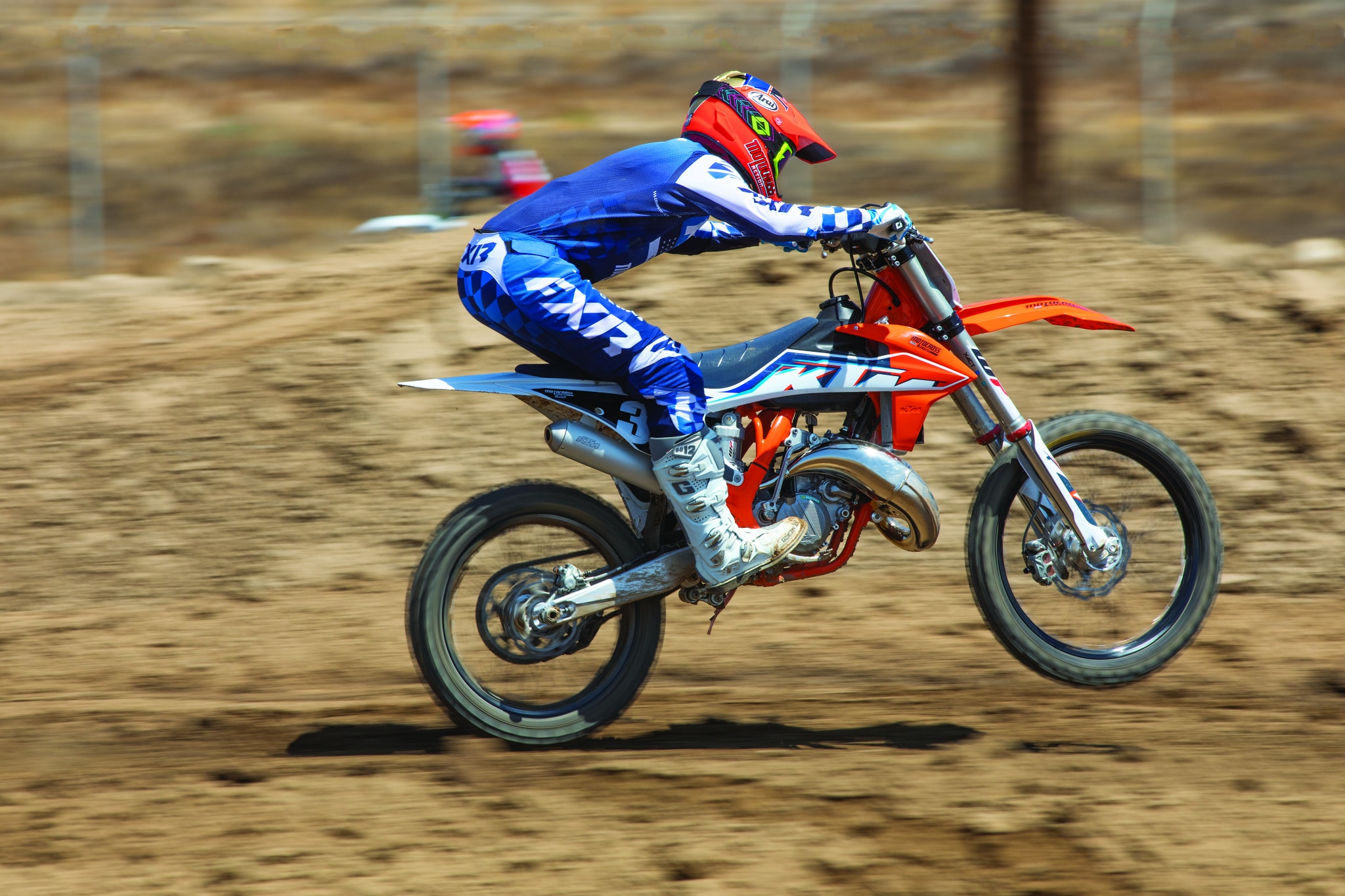 THE GEAR: Jersey: FXR Racing Revo Flow, Pants: FXR Racing Revo Flow, Helmet: Arai VX-Pro4, Goggles: Viral Brand Works Series, Boots: Gaerne SG12.
THE GEAR: Jersey: FXR Racing Revo Flow, Pants: FXR Racing Revo Flow, Helmet: Arai VX-Pro4, Goggles: Viral Brand Works Series, Boots: Gaerne SG12.
Q: FIRST AND FOREMOST, IS THE 2022 KTM 150SX BETTER THAN THE 2021 MODEL?
A: Only cosmetically, and that is up for debate. For 2022, KTM changed the frame color from black to orange across the entire KTM SX line. Most test riders liked the orange flair, but we have learned that others don’t. To each his own. Other than the change in frame color, KTM updated to much bolder graphics for 2022.
Q: WERE THERE ANY SIGNIFICANT CHANGES IN 2021?
A: There haven’t been any changes to the engine or chassis since 2019, and we are okay with that. In a world dominated by four-strokes, we are happy when manufacturers are giving their two-strokes any attention within a five-year time span. And, we are tickled pink when manufacturers still agree to build new two-strokes, especially since Kawasaki, Honda and Suzuki gave smokers the death knell over a decade ago. We are guessing they are still kicking themselves for that decision, given that KTM sells more two-strokes than they sell four-stroke motocross bikes. Yamaha is the only Japanese manufacturer that waited the market out and kept pumping out smokers—unchanged smokers, but smokers nevertheless. However, the demand for new smokers has been so great in recent years that the pencil-pushers at Yamaha found enough money in the budget to fund the first truly updated YZ125 in 16 years. We couldn’t be any more ecstatic about the new 2022 Yamaha YZ125.
Getting back to the 2022 KTM 150SX, two significant changes were made in 2021 to the forks and clutch. The WP XACT forks received all-new internals with improved oil-bypass notches, a new air seal with extra air bypass holes and an enlarged crossover bleed slot to help air move from the positive to the negative air chambers more easily. Plus, a new bump-stop rubber and an adjust-by-hand rebound clicker were also on the list. And, that wasn’t all. On the KTM, Husky and GasGas two-strokes, WP replaced the ingenious trampoline valve with a new float-valve shim setting at the mid-valve. These multiple fork changes were a major improvement in the forks’ overall action. The forks connected to the ground better and offered a linear, coil-spring-like feel in action. As for the KTM 150SX clutch, the clutch basket’s tangs were made thicker and stronger to hold up better over time.
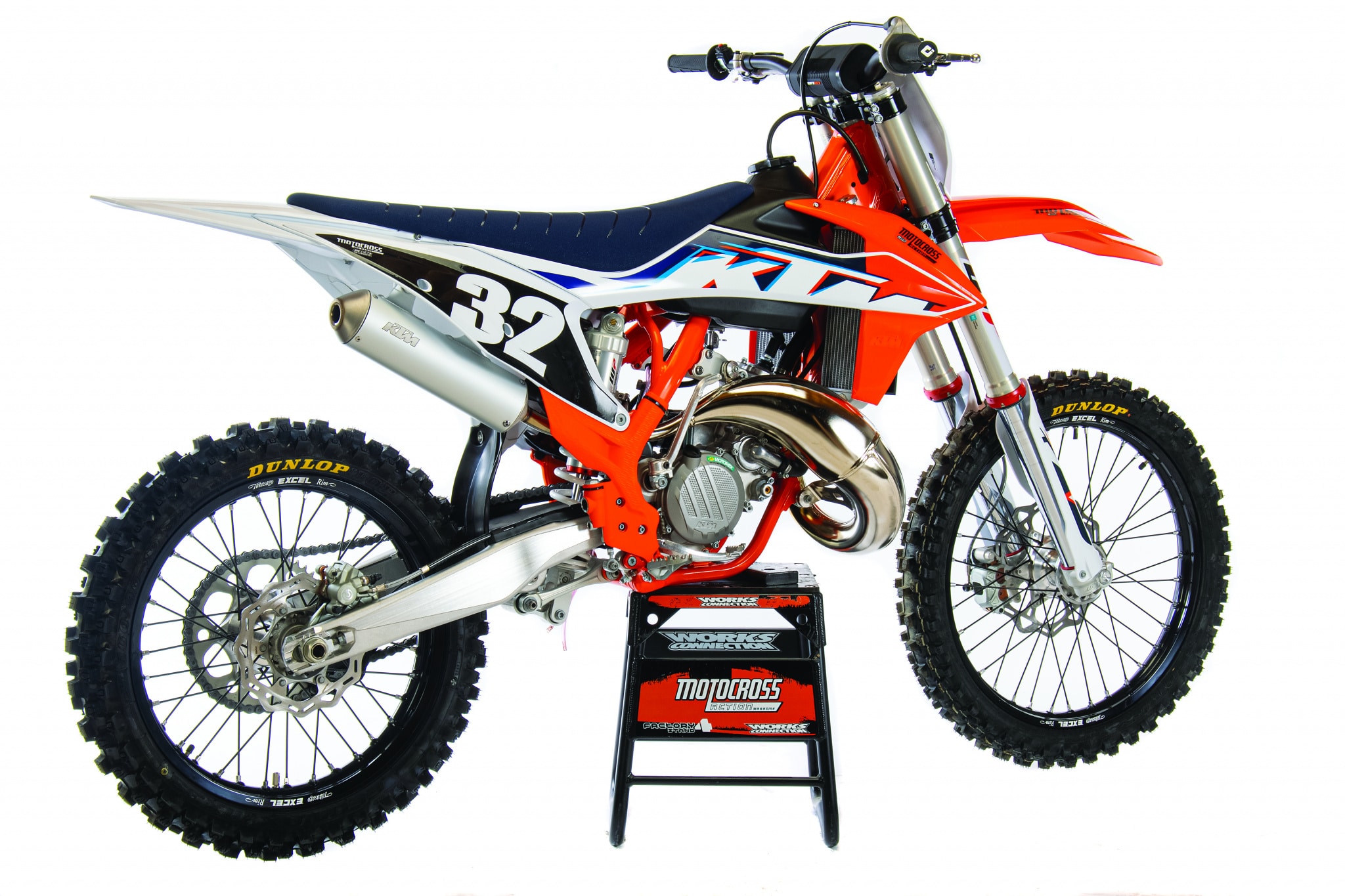 We applaud KTM for their two-stroke support. The KTM 150SX is powerful, fun and offers great bang for your buck.
We applaud KTM for their two-stroke support. The KTM 150SX is powerful, fun and offers great bang for your buck.
Q: IS A KTM 125SX OR KTM 150SX BETTER FOR YOU?
A: That is a loaded question. Both bikes have their charms and peccadilloes. The KTM 150SX does not have a purpose-built 150cc engine. Because the KTM 125SX and KTM 150SX use the same cases, castings, layout, exhaust and intake—only the piston size is different. Could KTM build an even better 150SX if they designed a completely new 150cc engine with its own bore and stroke like boutique Italian brand TM does? Yes! But, it would cost KTM a lot more R&D money to design a stand-alone 150SX engine—and that would mean that they would charge the buyer much more. In 2022, the price difference between a KTM 150SX and a KTM 125SX is $200 (for comparison, the price difference between a TM 125MX and the completely unique TM 144MX is over $1000).
Here is a quick breakdown of how the 2022 KTM 150SX and KTM 125SX differ.
KTM 150SX: This engine is the horsepower king of the two. It cracks the 40 horsepower barrier, producing three more ponies than the 125SX. It launches you out of corners with authority and will pull hard to get over the jumps; however, the powerful engine’s powerband revs through its rpm range in a quick burst of power and then signs off without much notice. This leaves little room for error with your shift points to get the most out of this package. The burst of power is great at the crack of the throttle. Although, when riders jump back and forth from the 125SX to the 150SX, they always ask, “What is different with the chassis or suspension?” It is always the same answer. Nothing. It is the surge of power that makes the 150SX chassis more erratic. In turns, this makes the rider more fatigued in a longer moto. Let’s not get too carried away, though. KTM offers a great chassis and suspension underneath both engines, but if you are looking for the best-handling bike of the two, the KTM 125SX is the winner.
KTM 125SX: It is obvious that with a 19.19cc smaller displacement than its bigger brother (the 150SX is really a 144cc engine), the 125SX is going to be down on power; however, KTM built the 125SX engine based on a 125cc engine, not a 150cc configuration. What we are trying to say is KTM tuned every aspect of the 125 engine to be as rider compliant as possible, which is the 125SX’s edge over the 150SX. The 125SX engine offers an ultra-easy-to-ride powerplant that is smooth as butter. You don’t have to shift on the bubble like with the 150SX; you can be lazy at keeping the rpm at 11,200 until the next corner without having to worry much about the power falling on its face. It may be the turtle in the race, but during long hard motos, experienced riders tend to lean toward racing the 125SX due to its fluid nature. Of course, if you race in sanctioned 125cc events, the 125 is legal and the 150SX is a cheater bike.
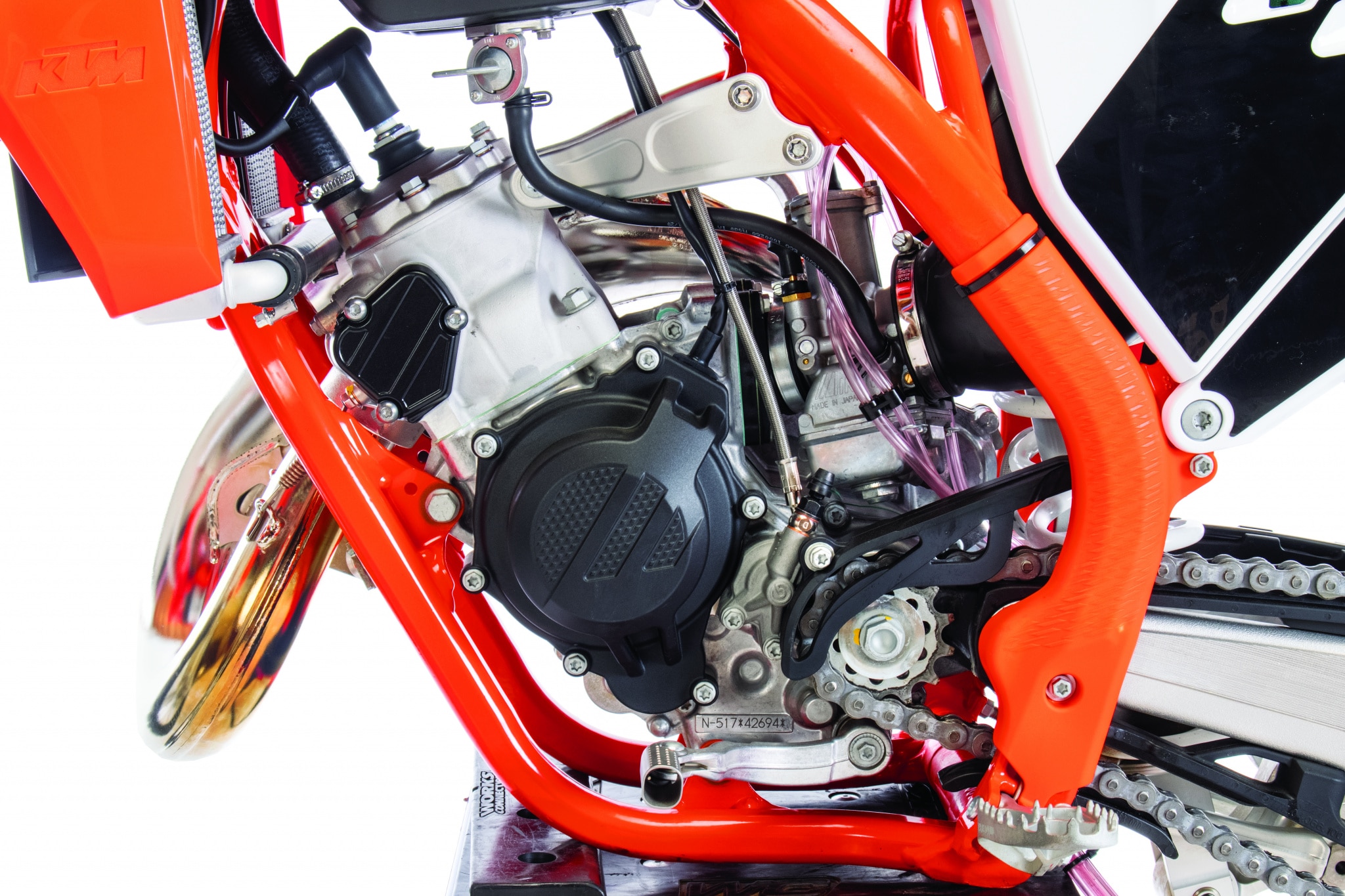 The 150SX engine is powerful off the bottom, hits hard in the middle then is quick to sign off after it hits the 40 horsepower barrier.
The 150SX engine is powerful off the bottom, hits hard in the middle then is quick to sign off after it hits the 40 horsepower barrier.
Q: WHAT DO WE THINK OF THE WP SUSPENSION COMPONENTS?
A: With small-displacement smokers, it isn’t as crucial to have great suspension or handling due to the ability of mature riders to manhandle them. For young riders transitioning from minicycles to big bikes, suspension and handling mean a lot to their confidence and speed. KTM hasn’t given up on its XACT air forks, and they won’t anytime soon. KTM had a huge breakthrough in performance in 2021 in terms of overall feel and performance. KTM’s air forks are now something to brag about. Best of all, they are still in the infancy stages of development, especially when compared to how long coil spring forks have been around.
Remember how horrible the Showa and Kayaba air forks were six years ago? Today, most of the factory riders are using air forks again. The WP XACT air forks are very good forks, thanks in no small part to WP’s test riders and engineers identifying the causes of their previous harshness and developing innovative solutions that have them surpassing Honda, Suzuki and Kawasaki forks. A click here or there and our testers were in their sweet spot. As for the WP shock, we don’t notice it most of the time due to how well it works.
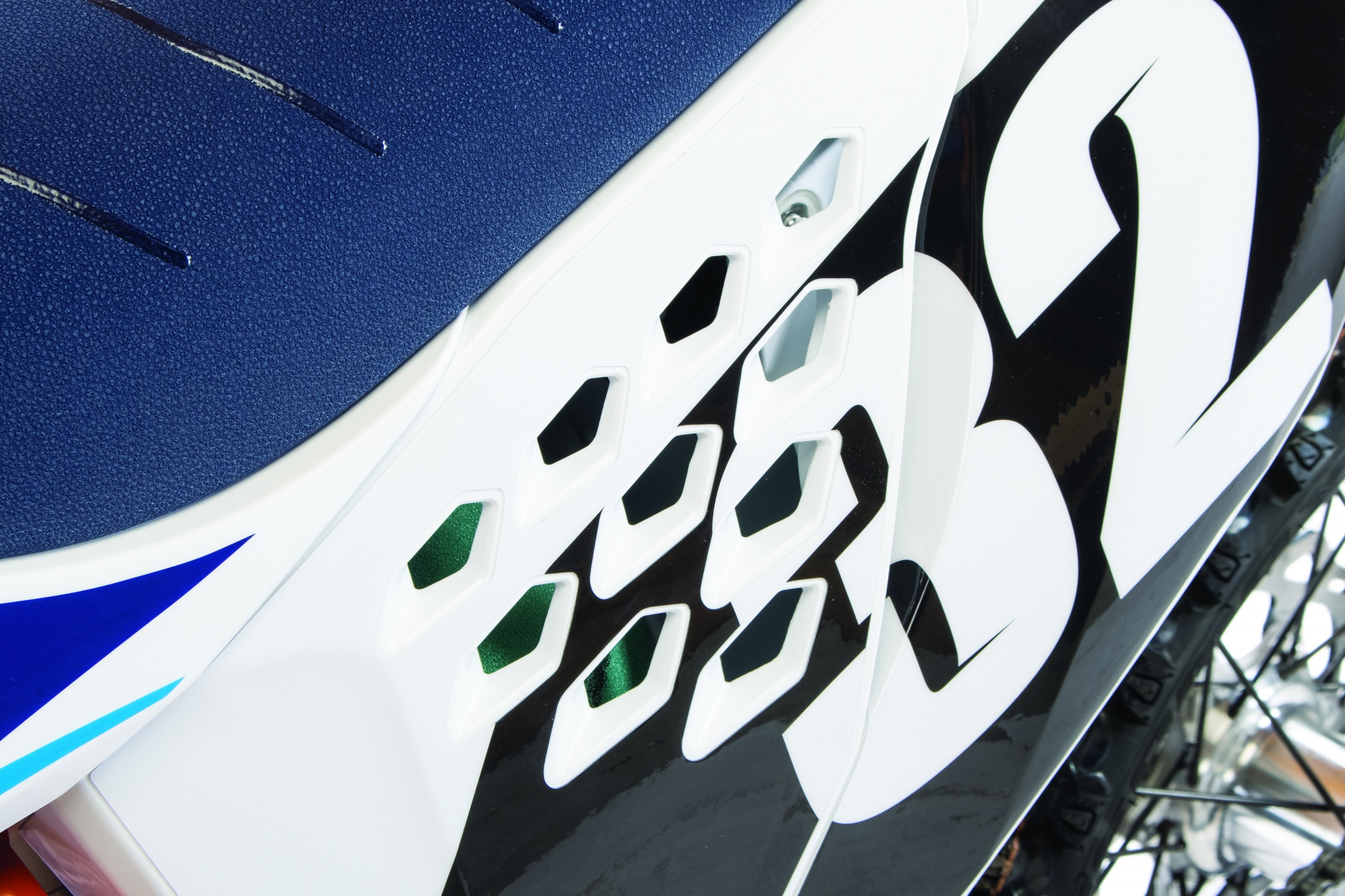 We immediately put on the optional vented air box cover to give the 150SX engine as much air as possible.
We immediately put on the optional vented air box cover to give the 150SX engine as much air as possible.
Q: WHAT ARE THE EASIEST WAYS TO MAKE THE 2022 KTM 150SX BETTER?
A: Small changes can make a big difference.
(1) Power-valve adjuster. KTM doesn’t like riders touching the power-valve adjuster on the left side of the cases, but we aren’t sure why. If they don’t want us touching it, why did they put an adjuster on it? We turn the square hole adjuster dial with a Robertson wrench (or a Kreft Powerdial or a flat-bladed screwdriver) either clockwise or counterclockwise depending on how the rider wants to change the power. On the KTM 150SX, most test riders wanted to smooth out the power spread. To do this, you turn the power valve adjuster in clockwise. Adjust in 1/4-turn to 1/2-turn increments. If you want more bark, turn the adjuster counterclockwise. Just be warned that this will bunch up the powerband, and it will sign off even sooner.
(2) Pipe. We had great luck with aftermarket FMF, Pro Circuit and Scalvini exhaust pipes on both the 125SX and 150SX. They livened up the powerband across the board.
(3) Gearing. Stock gearing on the 150SX is 13/48 (3.692 gear ratio). It’s a good combo for most experienced two-stroke racers, especially those who are skilled with the clutch and shift lever. Pro test riders preferred a 14/49 combination, which required changing both the countershaft and rear sprockets to deliver a taller 3.500 gear ratio. Pros had the talent to carry more speed with the taller gear ratios. Tighter tracks and less-skilled riders did better with a 14/50 blend (3.571 gear ratio). It wasn’t as punchy as the stock gearing and was a little easier to carry from gear to gear.
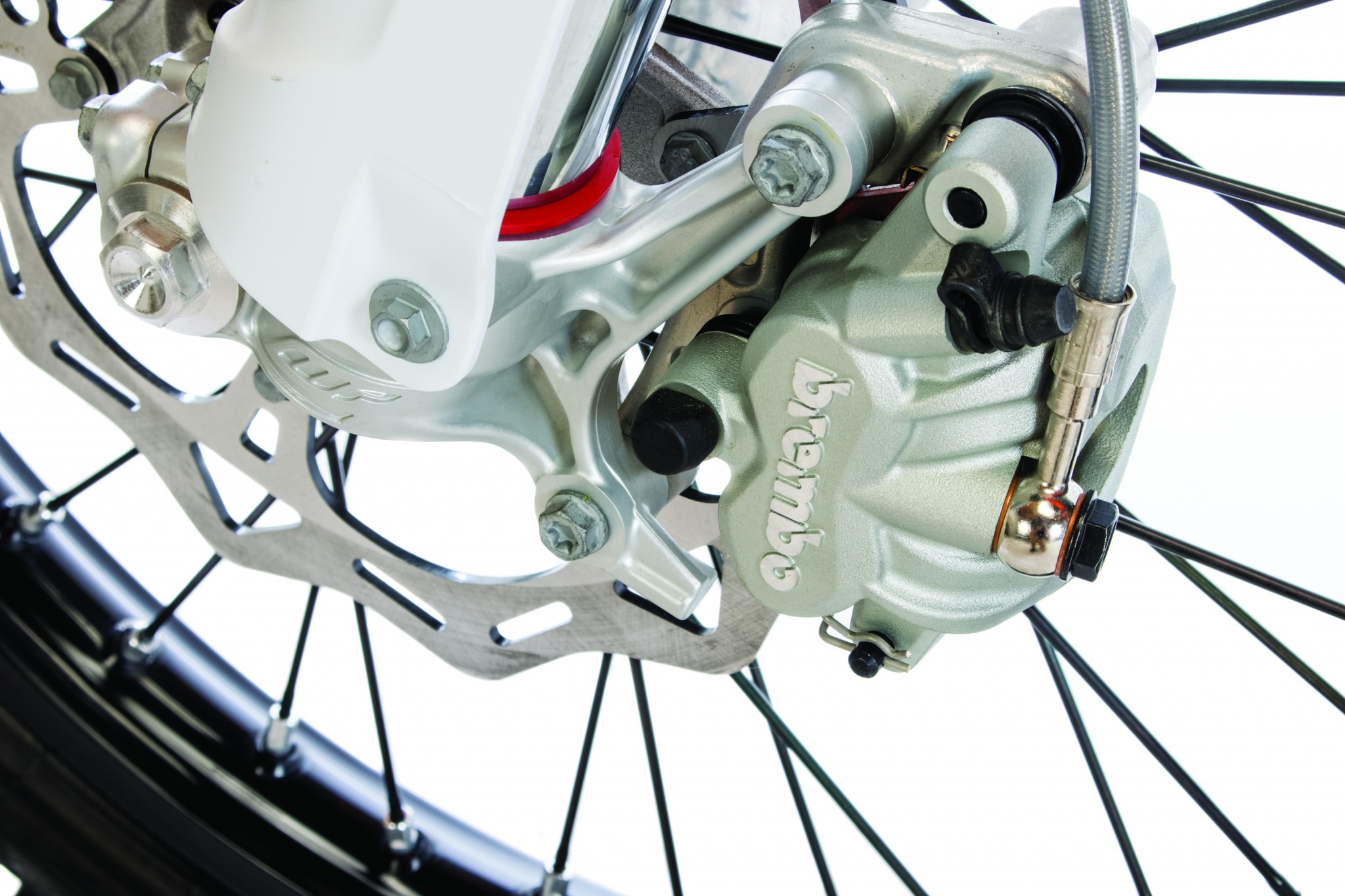 These are the same Brembo brakes that come standard on the KTM 450SXF and they stop on a dime. Imagine how they work on a bike that is 30 pounds lighter.
These are the same Brembo brakes that come standard on the KTM 450SXF and they stop on a dime. Imagine how they work on a bike that is 30 pounds lighter.
Q: WHAT DID WE HATE?
A: The hate list:
(1) Preload ring. If you have the extra dough, buy the Xtrig shock preload adjuster. It is a game-changer if you change sag a lot.
(2) Power-valve adjuster. The Robertson wrench (square) power-valve adjuster is useful, but why can’t KTM use a more common Allen wrench or the same #45 Torx wrench that fits other KTM bolts?
(3) Fork-bleed screw. The fork’s right-side air-bleed screw is a #15 Torx. KTM should go back to the Phillips-head screw that they used a few years back.
(4) Fork adjuster. The thin and short compression clicker starts to hurt your fingers after a few clicks. We like the fact that you can adjust the rebound damping by hand.
(5) Spokes. The spokes still come loose. If the spoke by the rim lock is loose (and it comes loose at regular intervals), there is a good chance the rest of them are loose as well.
(6) Watch list. The rigors of motocross have a way of loosening bolts. On the 2022 KTM 125SX, we pay attention to the head-stay bolts, lower subframe bolts, shift lever bolt and rear shock linkage nut. Also, it’s a good idea to remove the frame guards and check the swingarm bolt occasionally.
Q: WHAT DID WE LIKE
A: The like list:
(1) Weight. This bike is light at 194 pounds, and you feel it on the track.
(2) Brakes. The Brembo brakes on the 2022 KTM 150SX are the exact same brakes as on the more powerful and heavier 450SXF. If they stop the big bike with authority, imagine what they are capable of on a 30-pound-lighter 150.
(3) Hydraulic clutch. KTM’s self-adjusting clutch is ahead of its time. Go ahead and abuse it. It can take whatever you can dish out.
(4) Airbox cover. We like the no-tools airbox cover and the optional vented cover that comes with it. We always run the vented cover. It gives the tiddler more pep in its step.
(5) Air filter. KTM’s plug-in air filter cage makes changing an air filter such a simple task that you might actually do it.
(6) Engine. The power-to-weight ratio of the 150SX allows it to compete with some of the 250F bottom feeders.
(7) Suspension. The WP suspension components are better than most spring forks on the market.
(8) Tires. The 150SX comes with Dunlop Geomax MX33 tires front and rear. Our tire of choice.
(9) Grips. The lock-on ODI grips are comfortable and are much easier to change than the vulcanized grips some manufacturers still use. If you want plusher grips, glue-on grips have twice as much rubber as a lock-on grip.
(10) Ergonomics. This is an easy bike to feel comfortable on. It’s slim, light and agile.
Q: WHAT DO WE REALLY THINK?
A: The KTM 150SX is a great bike from top to bottom. We love riding this bike, but don’t like racing it as much as we do the KTM 125SX. The exception to this rule is when we race on sandy or hill tracks like Glen Helen, where 150cc oomph outweighs 125cc precision. This KTM 150SX is great for what it is, which is a bike without a sanctioned class; however, for the hardcore play rider, the 150SX is fun, light, powerful and offers some of the best components on the market. We appreciate this two-stroke.
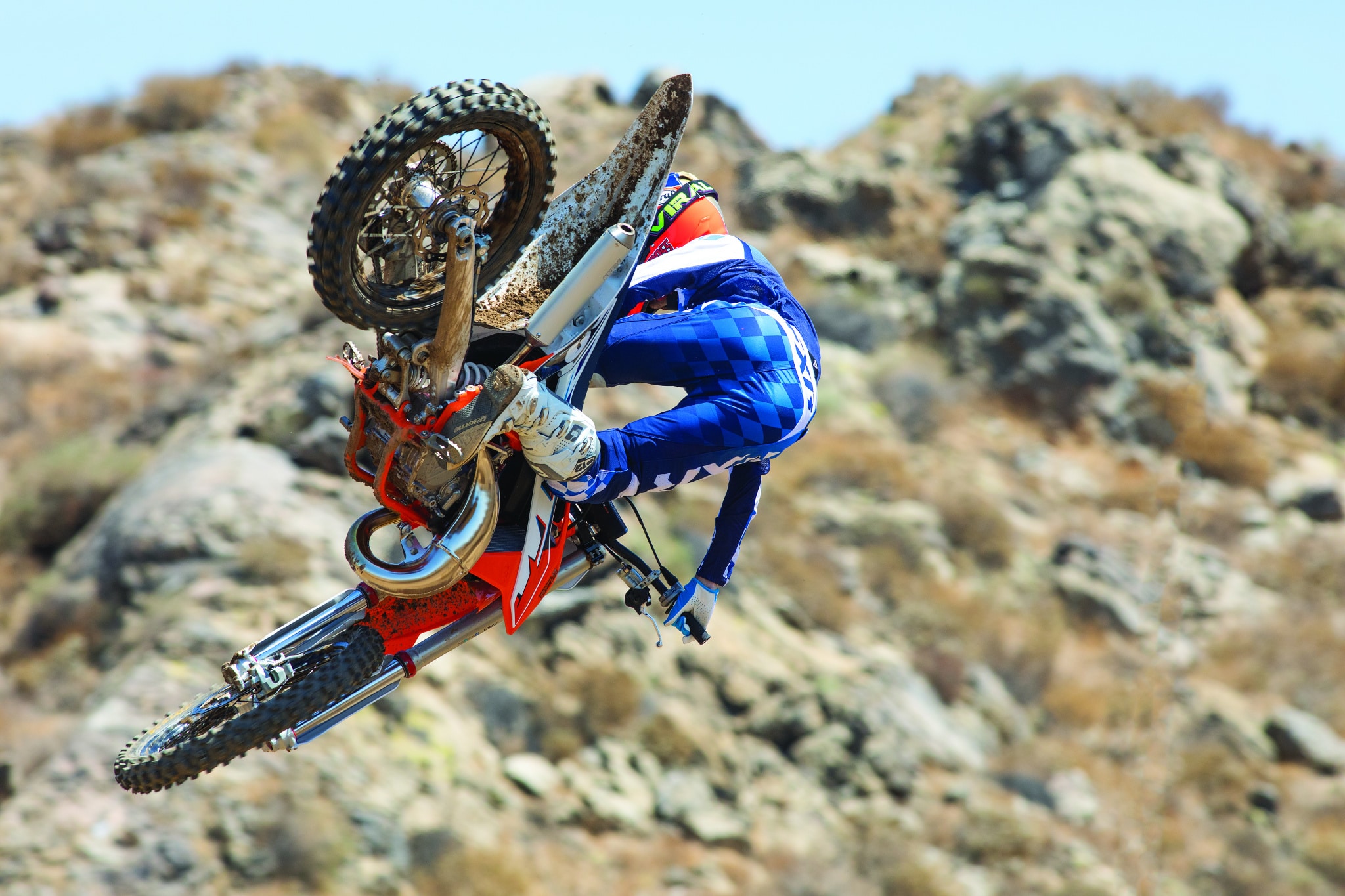 If you are debating on getting a KTM 125SX or KTM 150SX, this is what the 150SX is better at doing, getting over jumps.
If you are debating on getting a KTM 125SX or KTM 150SX, this is what the 150SX is better at doing, getting over jumps.
MXA’S 2022 KTM 150SX SETUP SPECS
This is how we set up our 2022 KTM 150SX for racing. We offer it as a guide to help you find your own sweet spot.
WP XACT FORK SETTINGS
First, focus on balancing out the bike for your weight by adjusting the air in the forks. If the forks are diving into corners, go up a few psi. If they tend to be rigid and pushing out on the entrance of corners, drop the psi down a few points. The forks have good bottoming resistance, so going softer for a plusher ride is not an issue. For hardcore racing, we recommend this fork setup for the 2022 KTM 150SX (stock settings in parentheses).
Air pressure: 120 psi
Compression: 12 clicks out
Rebound: 18 clicks out
Fork-leg height: Stock
Notes: Make sure to check your air pressure and bleed both of the air screws on the top of the forks each ride. Don’t obsess on air pressure. Get it in the ballpark for your weight, speed and track, and use the compression clicker to handle the rest. The KTM 150SX is sensitive to fork height. For most tracks, the second line on the forks is fine, but it you want it to turn sharper, go to the third line.
WP SHOCK SETTINGS
After we set sag at 106mm, most riders didn’t change a thing. For hardcore racing, we recommend this shock setup for the 2022 KTM 150SX (stock specs are in parentheses):
Spring rate: 39 N/mm
Race sag: 106mm
Hi-compression: 2 turns out
Lo-compression: 12 turns out
Rebound: 15 turns out
Notes: The stock shock settings are in the ballpark.
MIKUNI TMX 38MM JETTING SPEC
Here’s what we ran in our 38mm Mikuni TMX carb.
Main jet: 500
Pilot: 35
Needle: 6BFY43-71
Clip: 2nd
Air screw: 2.5 turns out
Notes: Back in 2017, KTM swapped the tried-and-true Keihin carb for an untested 38mm Mikuni TMX carb. We knew it was untested, because they wanted KTM owners to switch from their favorite pre-mix ratio to a leaner 60:1 mixture. In 2018, KTM responded to owners’ complaints and did away with the weird 60:1 fuel/oil ratio. In 2019, KTM went to a bigger main jet and different needle. These jetting changes were a big plus and work well on a stock engine.



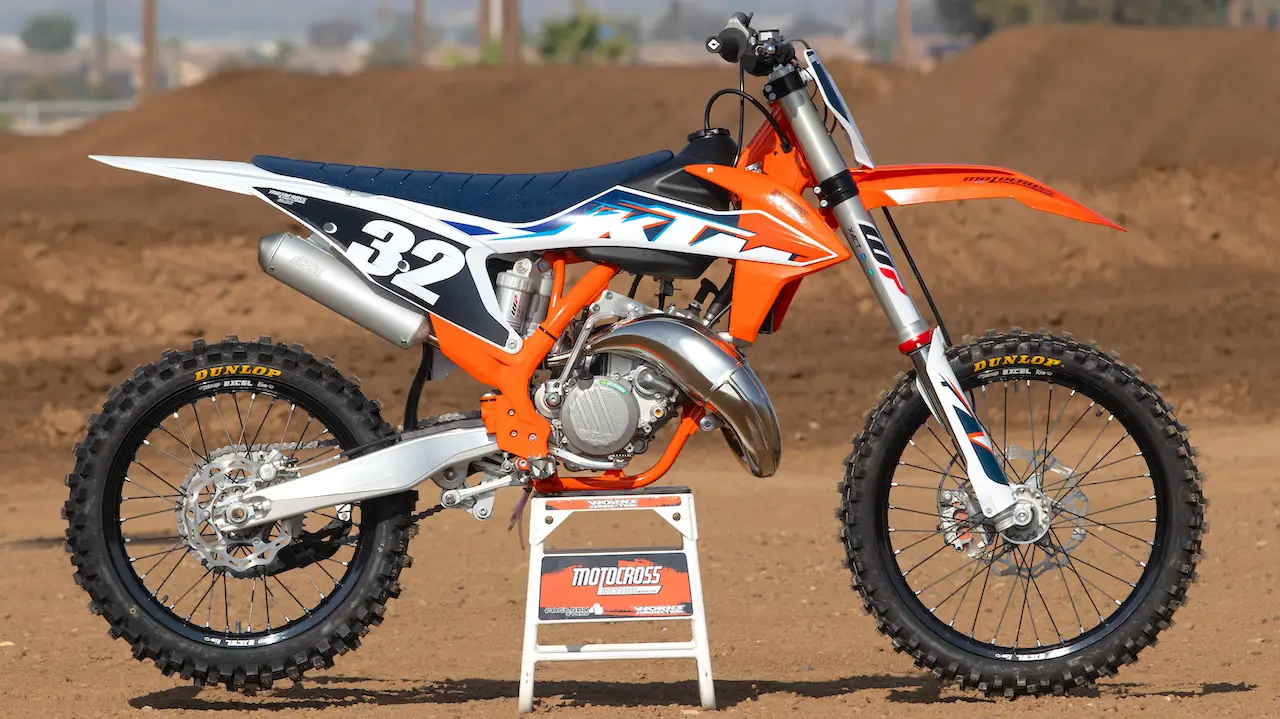


Comments are closed.